Acute Appendicitis in Children
VerifiedAdded on 2020/02/18
|11
|2579
|65
AI Summary
This assignment delves into acute appendicitis in children, highlighting lymphoid hyperplasia as the primary risk factor and its connection to viral infections like gastroenteritis and mononucleosis. It examines the surgical treatment of appendicitis and emphasizes the importance of family-centered care, including open communication and addressing potential emotional distress experienced by both the child and her family.
Contribute Materials
Your contribution can guide someone’s learning journey. Share your
documents today.
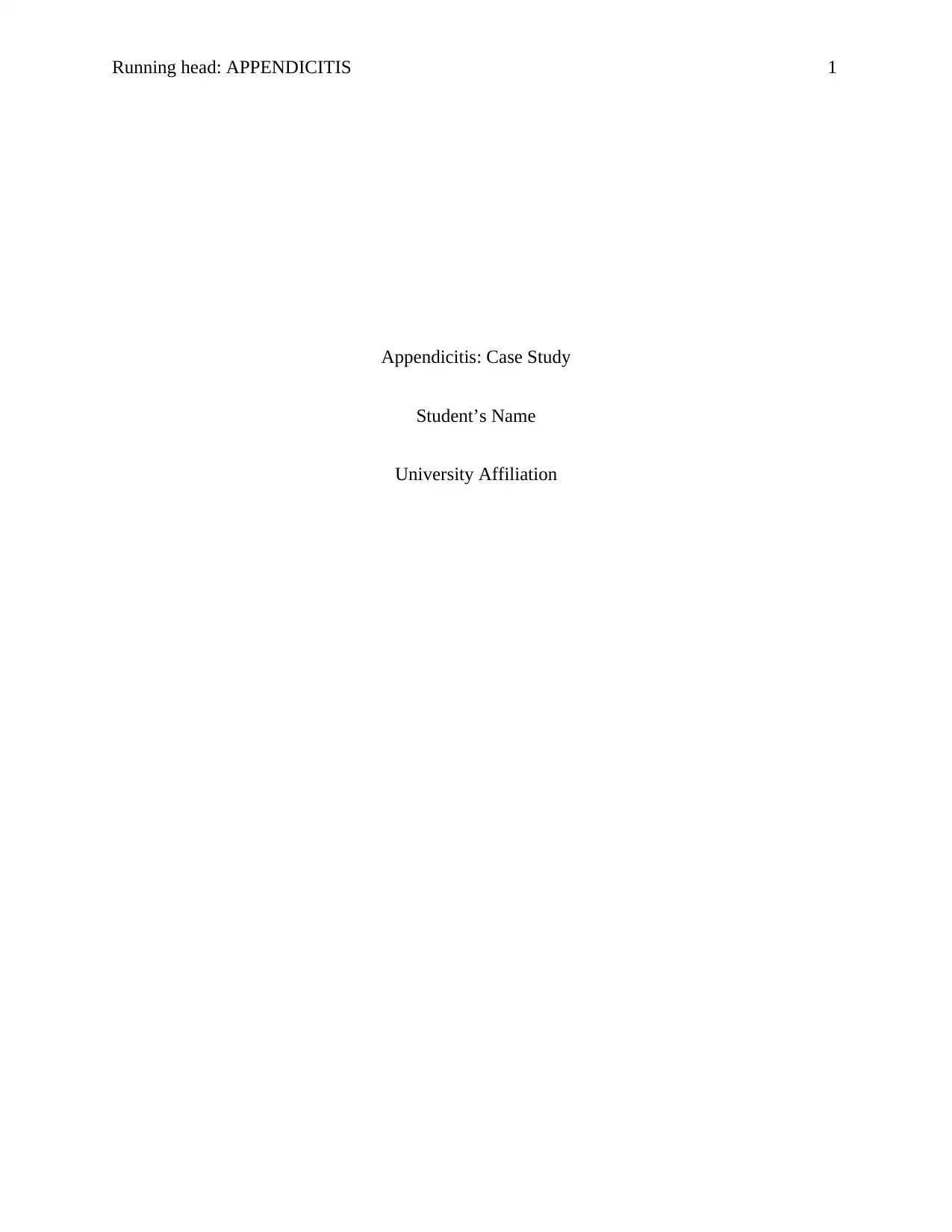
Running head: APPENDICITIS 1
Appendicitis: Case Study
Student’s Name
University Affiliation
Appendicitis: Case Study
Student’s Name
University Affiliation
Secure Best Marks with AI Grader
Need help grading? Try our AI Grader for instant feedback on your assignments.
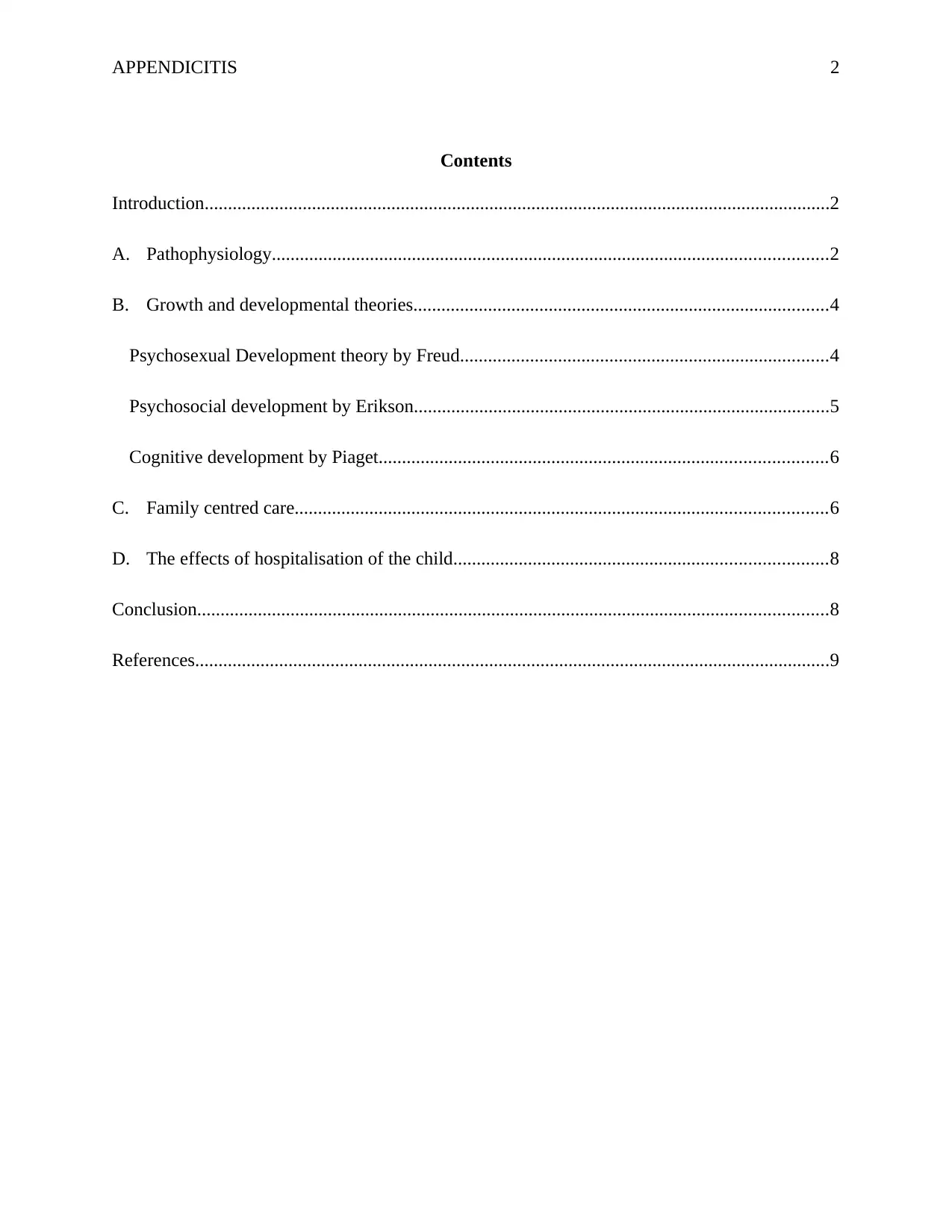
APPENDICITIS 2
Contents
Introduction......................................................................................................................................2
A. Pathophysiology.......................................................................................................................2
B. Growth and developmental theories.........................................................................................4
Psychosexual Development theory by Freud...............................................................................4
Psychosocial development by Erikson.........................................................................................5
Cognitive development by Piaget................................................................................................6
C. Family centred care..................................................................................................................6
D. The effects of hospitalisation of the child................................................................................8
Conclusion.......................................................................................................................................8
References........................................................................................................................................9
Contents
Introduction......................................................................................................................................2
A. Pathophysiology.......................................................................................................................2
B. Growth and developmental theories.........................................................................................4
Psychosexual Development theory by Freud...............................................................................4
Psychosocial development by Erikson.........................................................................................5
Cognitive development by Piaget................................................................................................6
C. Family centred care..................................................................................................................6
D. The effects of hospitalisation of the child................................................................................8
Conclusion.......................................................................................................................................8
References........................................................................................................................................9
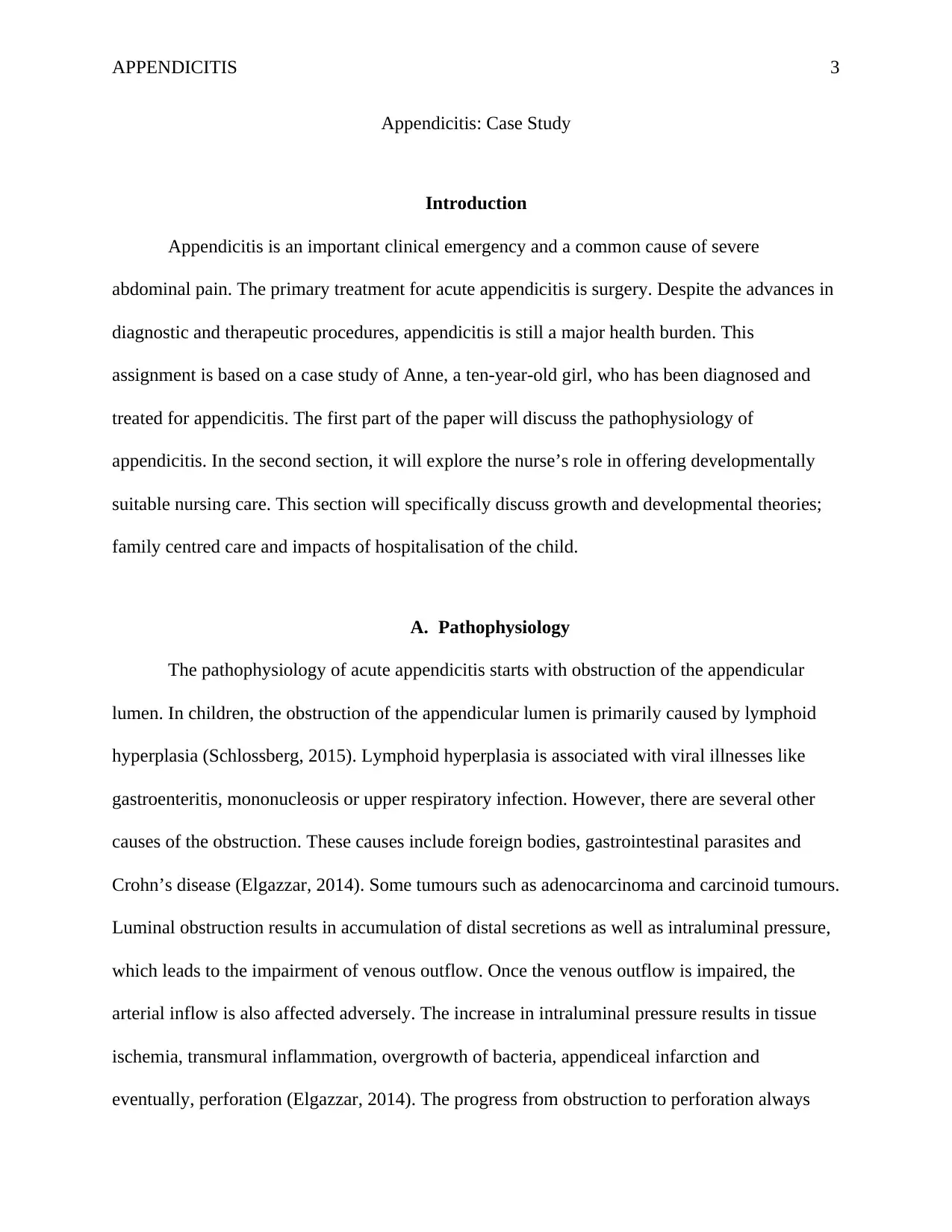
APPENDICITIS 3
Appendicitis: Case Study
Introduction
Appendicitis is an important clinical emergency and a common cause of severe
abdominal pain. The primary treatment for acute appendicitis is surgery. Despite the advances in
diagnostic and therapeutic procedures, appendicitis is still a major health burden. This
assignment is based on a case study of Anne, a ten-year-old girl, who has been diagnosed and
treated for appendicitis. The first part of the paper will discuss the pathophysiology of
appendicitis. In the second section, it will explore the nurse’s role in offering developmentally
suitable nursing care. This section will specifically discuss growth and developmental theories;
family centred care and impacts of hospitalisation of the child.
A. Pathophysiology
The pathophysiology of acute appendicitis starts with obstruction of the appendicular
lumen. In children, the obstruction of the appendicular lumen is primarily caused by lymphoid
hyperplasia (Schlossberg, 2015). Lymphoid hyperplasia is associated with viral illnesses like
gastroenteritis, mononucleosis or upper respiratory infection. However, there are several other
causes of the obstruction. These causes include foreign bodies, gastrointestinal parasites and
Crohn’s disease (Elgazzar, 2014). Some tumours such as adenocarcinoma and carcinoid tumours.
Luminal obstruction results in accumulation of distal secretions as well as intraluminal pressure,
which leads to the impairment of venous outflow. Once the venous outflow is impaired, the
arterial inflow is also affected adversely. The increase in intraluminal pressure results in tissue
ischemia, transmural inflammation, overgrowth of bacteria, appendiceal infarction and
eventually, perforation (Elgazzar, 2014). The progress from obstruction to perforation always
Appendicitis: Case Study
Introduction
Appendicitis is an important clinical emergency and a common cause of severe
abdominal pain. The primary treatment for acute appendicitis is surgery. Despite the advances in
diagnostic and therapeutic procedures, appendicitis is still a major health burden. This
assignment is based on a case study of Anne, a ten-year-old girl, who has been diagnosed and
treated for appendicitis. The first part of the paper will discuss the pathophysiology of
appendicitis. In the second section, it will explore the nurse’s role in offering developmentally
suitable nursing care. This section will specifically discuss growth and developmental theories;
family centred care and impacts of hospitalisation of the child.
A. Pathophysiology
The pathophysiology of acute appendicitis starts with obstruction of the appendicular
lumen. In children, the obstruction of the appendicular lumen is primarily caused by lymphoid
hyperplasia (Schlossberg, 2015). Lymphoid hyperplasia is associated with viral illnesses like
gastroenteritis, mononucleosis or upper respiratory infection. However, there are several other
causes of the obstruction. These causes include foreign bodies, gastrointestinal parasites and
Crohn’s disease (Elgazzar, 2014). Some tumours such as adenocarcinoma and carcinoid tumours.
Luminal obstruction results in accumulation of distal secretions as well as intraluminal pressure,
which leads to the impairment of venous outflow. Once the venous outflow is impaired, the
arterial inflow is also affected adversely. The increase in intraluminal pressure results in tissue
ischemia, transmural inflammation, overgrowth of bacteria, appendiceal infarction and
eventually, perforation (Elgazzar, 2014). The progress from obstruction to perforation always
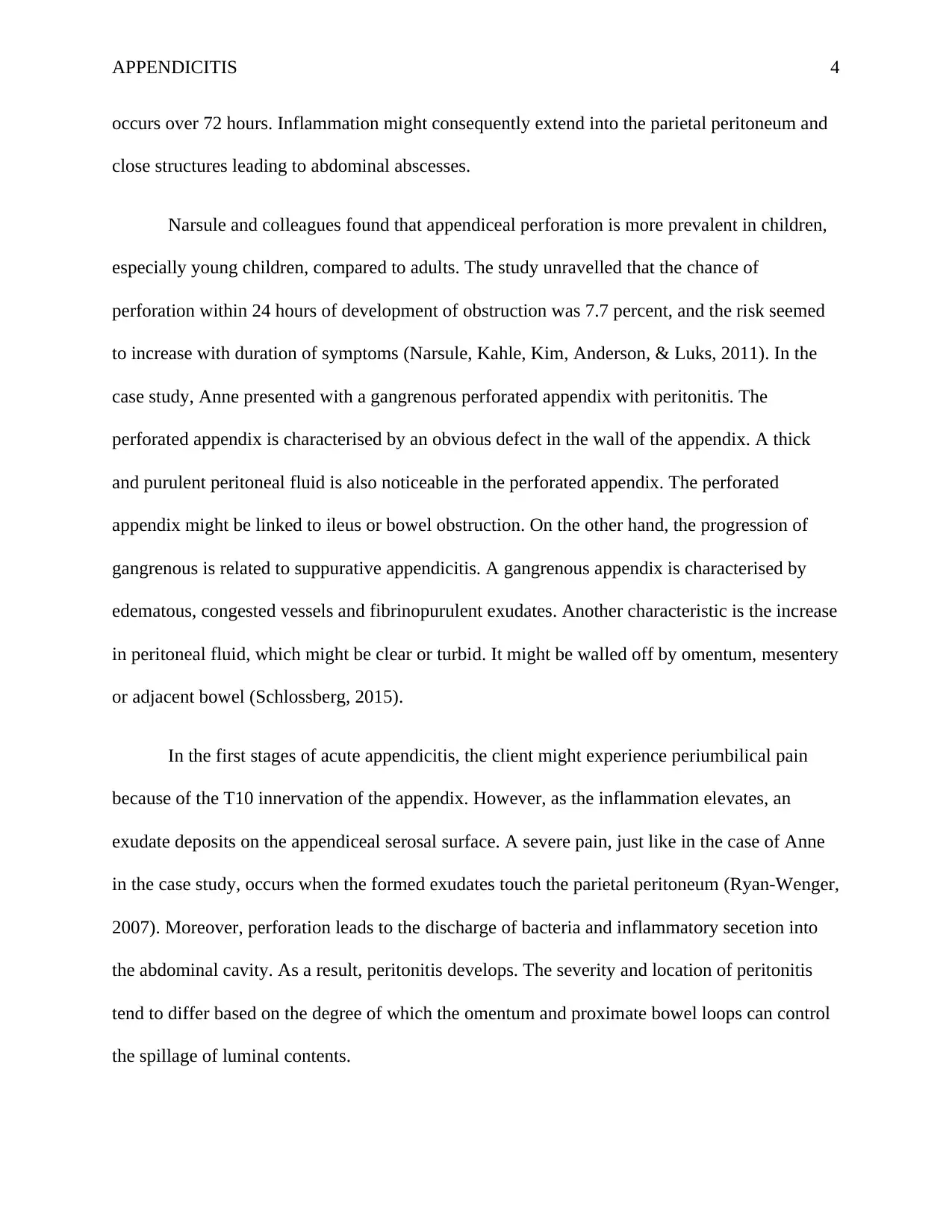
APPENDICITIS 4
occurs over 72 hours. Inflammation might consequently extend into the parietal peritoneum and
close structures leading to abdominal abscesses.
Narsule and colleagues found that appendiceal perforation is more prevalent in children,
especially young children, compared to adults. The study unravelled that the chance of
perforation within 24 hours of development of obstruction was 7.7 percent, and the risk seemed
to increase with duration of symptoms (Narsule, Kahle, Kim, Anderson, & Luks, 2011). In the
case study, Anne presented with a gangrenous perforated appendix with peritonitis. The
perforated appendix is characterised by an obvious defect in the wall of the appendix. A thick
and purulent peritoneal fluid is also noticeable in the perforated appendix. The perforated
appendix might be linked to ileus or bowel obstruction. On the other hand, the progression of
gangrenous is related to suppurative appendicitis. A gangrenous appendix is characterised by
edematous, congested vessels and fibrinopurulent exudates. Another characteristic is the increase
in peritoneal fluid, which might be clear or turbid. It might be walled off by omentum, mesentery
or adjacent bowel (Schlossberg, 2015).
In the first stages of acute appendicitis, the client might experience periumbilical pain
because of the T10 innervation of the appendix. However, as the inflammation elevates, an
exudate deposits on the appendiceal serosal surface. A severe pain, just like in the case of Anne
in the case study, occurs when the formed exudates touch the parietal peritoneum (Ryan-Wenger,
2007). Moreover, perforation leads to the discharge of bacteria and inflammatory secetion into
the abdominal cavity. As a result, peritonitis develops. The severity and location of peritonitis
tend to differ based on the degree of which the omentum and proximate bowel loops can control
the spillage of luminal contents.
occurs over 72 hours. Inflammation might consequently extend into the parietal peritoneum and
close structures leading to abdominal abscesses.
Narsule and colleagues found that appendiceal perforation is more prevalent in children,
especially young children, compared to adults. The study unravelled that the chance of
perforation within 24 hours of development of obstruction was 7.7 percent, and the risk seemed
to increase with duration of symptoms (Narsule, Kahle, Kim, Anderson, & Luks, 2011). In the
case study, Anne presented with a gangrenous perforated appendix with peritonitis. The
perforated appendix is characterised by an obvious defect in the wall of the appendix. A thick
and purulent peritoneal fluid is also noticeable in the perforated appendix. The perforated
appendix might be linked to ileus or bowel obstruction. On the other hand, the progression of
gangrenous is related to suppurative appendicitis. A gangrenous appendix is characterised by
edematous, congested vessels and fibrinopurulent exudates. Another characteristic is the increase
in peritoneal fluid, which might be clear or turbid. It might be walled off by omentum, mesentery
or adjacent bowel (Schlossberg, 2015).
In the first stages of acute appendicitis, the client might experience periumbilical pain
because of the T10 innervation of the appendix. However, as the inflammation elevates, an
exudate deposits on the appendiceal serosal surface. A severe pain, just like in the case of Anne
in the case study, occurs when the formed exudates touch the parietal peritoneum (Ryan-Wenger,
2007). Moreover, perforation leads to the discharge of bacteria and inflammatory secetion into
the abdominal cavity. As a result, peritonitis develops. The severity and location of peritonitis
tend to differ based on the degree of which the omentum and proximate bowel loops can control
the spillage of luminal contents.
Secure Best Marks with AI Grader
Need help grading? Try our AI Grader for instant feedback on your assignments.
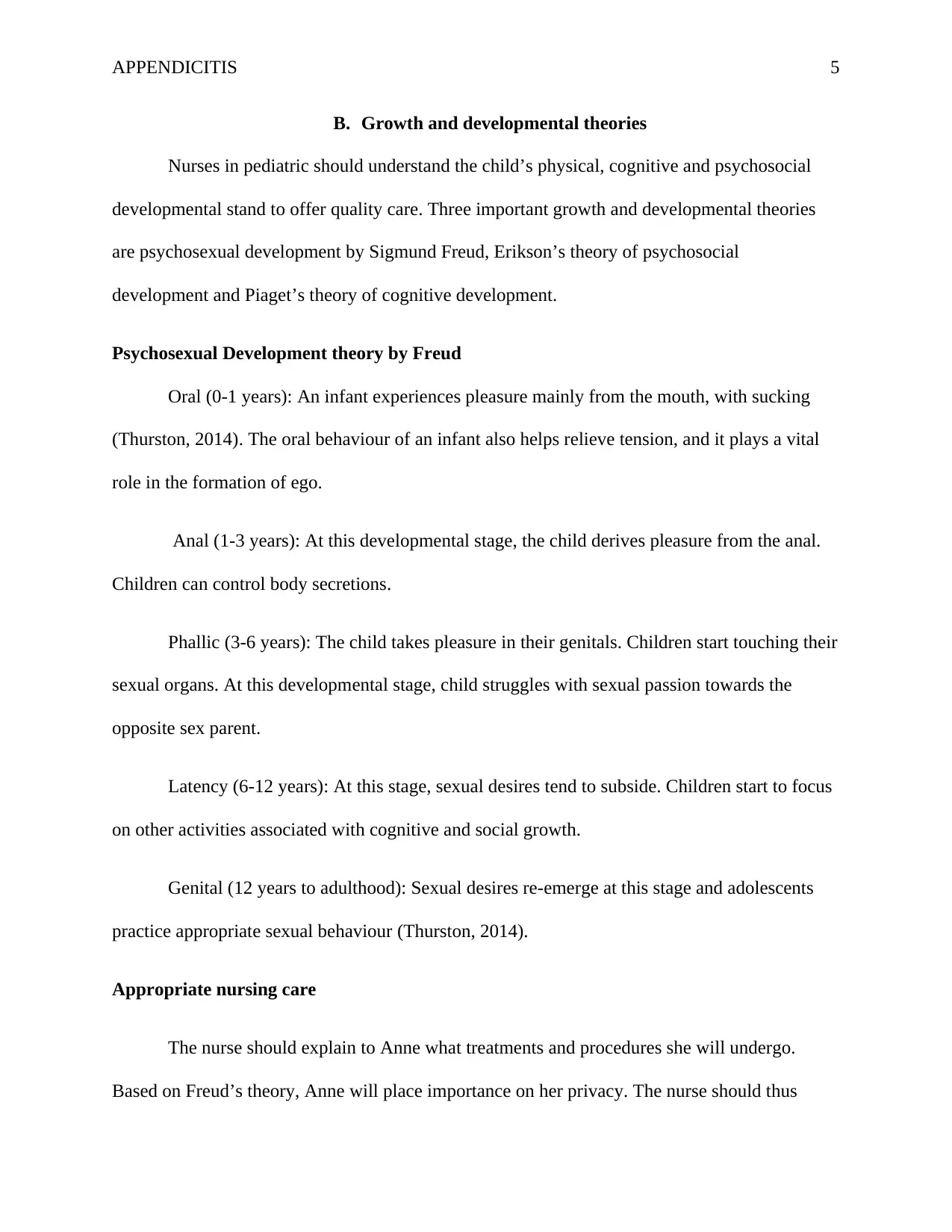
APPENDICITIS 5
B. Growth and developmental theories
Nurses in pediatric should understand the child’s physical, cognitive and psychosocial
developmental stand to offer quality care. Three important growth and developmental theories
are psychosexual development by Sigmund Freud, Erikson’s theory of psychosocial
development and Piaget’s theory of cognitive development.
Psychosexual Development theory by Freud
Oral (0-1 years): An infant experiences pleasure mainly from the mouth, with sucking
(Thurston, 2014). The oral behaviour of an infant also helps relieve tension, and it plays a vital
role in the formation of ego.
Anal (1-3 years): At this developmental stage, the child derives pleasure from the anal.
Children can control body secretions.
Phallic (3-6 years): The child takes pleasure in their genitals. Children start touching their
sexual organs. At this developmental stage, child struggles with sexual passion towards the
opposite sex parent.
Latency (6-12 years): At this stage, sexual desires tend to subside. Children start to focus
on other activities associated with cognitive and social growth.
Genital (12 years to adulthood): Sexual desires re-emerge at this stage and adolescents
practice appropriate sexual behaviour (Thurston, 2014).
Appropriate nursing care
The nurse should explain to Anne what treatments and procedures she will undergo.
Based on Freud’s theory, Anne will place importance on her privacy. The nurse should thus
B. Growth and developmental theories
Nurses in pediatric should understand the child’s physical, cognitive and psychosocial
developmental stand to offer quality care. Three important growth and developmental theories
are psychosexual development by Sigmund Freud, Erikson’s theory of psychosocial
development and Piaget’s theory of cognitive development.
Psychosexual Development theory by Freud
Oral (0-1 years): An infant experiences pleasure mainly from the mouth, with sucking
(Thurston, 2014). The oral behaviour of an infant also helps relieve tension, and it plays a vital
role in the formation of ego.
Anal (1-3 years): At this developmental stage, the child derives pleasure from the anal.
Children can control body secretions.
Phallic (3-6 years): The child takes pleasure in their genitals. Children start touching their
sexual organs. At this developmental stage, child struggles with sexual passion towards the
opposite sex parent.
Latency (6-12 years): At this stage, sexual desires tend to subside. Children start to focus
on other activities associated with cognitive and social growth.
Genital (12 years to adulthood): Sexual desires re-emerge at this stage and adolescents
practice appropriate sexual behaviour (Thurston, 2014).
Appropriate nursing care
The nurse should explain to Anne what treatments and procedures she will undergo.
Based on Freud’s theory, Anne will place importance on her privacy. The nurse should thus
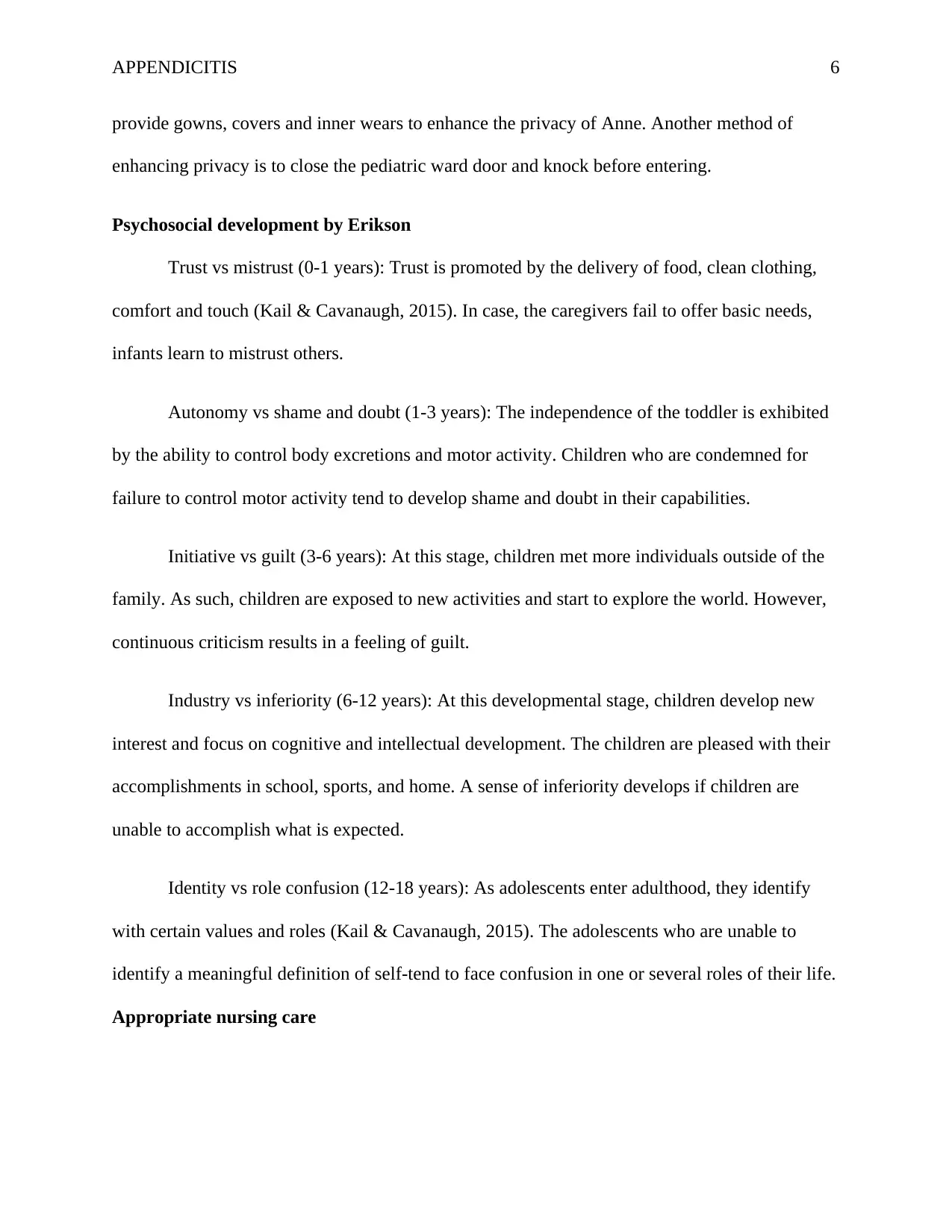
APPENDICITIS 6
provide gowns, covers and inner wears to enhance the privacy of Anne. Another method of
enhancing privacy is to close the pediatric ward door and knock before entering.
Psychosocial development by Erikson
Trust vs mistrust (0-1 years): Trust is promoted by the delivery of food, clean clothing,
comfort and touch (Kail & Cavanaugh, 2015). In case, the caregivers fail to offer basic needs,
infants learn to mistrust others.
Autonomy vs shame and doubt (1-3 years): The independence of the toddler is exhibited
by the ability to control body excretions and motor activity. Children who are condemned for
failure to control motor activity tend to develop shame and doubt in their capabilities.
Initiative vs guilt (3-6 years): At this stage, children met more individuals outside of the
family. As such, children are exposed to new activities and start to explore the world. However,
continuous criticism results in a feeling of guilt.
Industry vs inferiority (6-12 years): At this developmental stage, children develop new
interest and focus on cognitive and intellectual development. The children are pleased with their
accomplishments in school, sports, and home. A sense of inferiority develops if children are
unable to accomplish what is expected.
Identity vs role confusion (12-18 years): As adolescents enter adulthood, they identify
with certain values and roles (Kail & Cavanaugh, 2015). The adolescents who are unable to
identify a meaningful definition of self-tend to face confusion in one or several roles of their life.
Appropriate nursing care
provide gowns, covers and inner wears to enhance the privacy of Anne. Another method of
enhancing privacy is to close the pediatric ward door and knock before entering.
Psychosocial development by Erikson
Trust vs mistrust (0-1 years): Trust is promoted by the delivery of food, clean clothing,
comfort and touch (Kail & Cavanaugh, 2015). In case, the caregivers fail to offer basic needs,
infants learn to mistrust others.
Autonomy vs shame and doubt (1-3 years): The independence of the toddler is exhibited
by the ability to control body excretions and motor activity. Children who are condemned for
failure to control motor activity tend to develop shame and doubt in their capabilities.
Initiative vs guilt (3-6 years): At this stage, children met more individuals outside of the
family. As such, children are exposed to new activities and start to explore the world. However,
continuous criticism results in a feeling of guilt.
Industry vs inferiority (6-12 years): At this developmental stage, children develop new
interest and focus on cognitive and intellectual development. The children are pleased with their
accomplishments in school, sports, and home. A sense of inferiority develops if children are
unable to accomplish what is expected.
Identity vs role confusion (12-18 years): As adolescents enter adulthood, they identify
with certain values and roles (Kail & Cavanaugh, 2015). The adolescents who are unable to
identify a meaningful definition of self-tend to face confusion in one or several roles of their life.
Appropriate nursing care
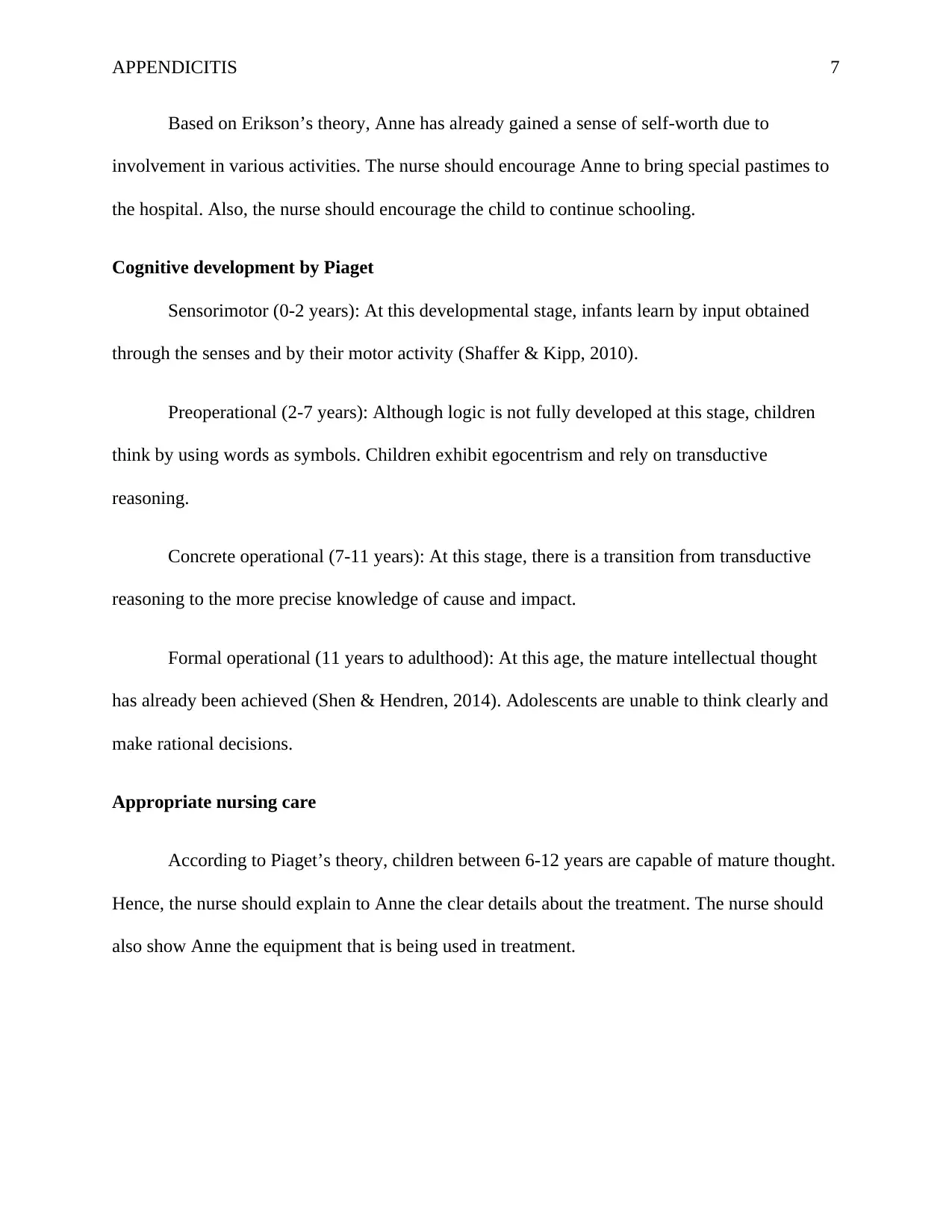
APPENDICITIS 7
Based on Erikson’s theory, Anne has already gained a sense of self-worth due to
involvement in various activities. The nurse should encourage Anne to bring special pastimes to
the hospital. Also, the nurse should encourage the child to continue schooling.
Cognitive development by Piaget
Sensorimotor (0-2 years): At this developmental stage, infants learn by input obtained
through the senses and by their motor activity (Shaffer & Kipp, 2010).
Preoperational (2-7 years): Although logic is not fully developed at this stage, children
think by using words as symbols. Children exhibit egocentrism and rely on transductive
reasoning.
Concrete operational (7-11 years): At this stage, there is a transition from transductive
reasoning to the more precise knowledge of cause and impact.
Formal operational (11 years to adulthood): At this age, the mature intellectual thought
has already been achieved (Shen & Hendren, 2014). Adolescents are unable to think clearly and
make rational decisions.
Appropriate nursing care
According to Piaget’s theory, children between 6-12 years are capable of mature thought.
Hence, the nurse should explain to Anne the clear details about the treatment. The nurse should
also show Anne the equipment that is being used in treatment.
Based on Erikson’s theory, Anne has already gained a sense of self-worth due to
involvement in various activities. The nurse should encourage Anne to bring special pastimes to
the hospital. Also, the nurse should encourage the child to continue schooling.
Cognitive development by Piaget
Sensorimotor (0-2 years): At this developmental stage, infants learn by input obtained
through the senses and by their motor activity (Shaffer & Kipp, 2010).
Preoperational (2-7 years): Although logic is not fully developed at this stage, children
think by using words as symbols. Children exhibit egocentrism and rely on transductive
reasoning.
Concrete operational (7-11 years): At this stage, there is a transition from transductive
reasoning to the more precise knowledge of cause and impact.
Formal operational (11 years to adulthood): At this age, the mature intellectual thought
has already been achieved (Shen & Hendren, 2014). Adolescents are unable to think clearly and
make rational decisions.
Appropriate nursing care
According to Piaget’s theory, children between 6-12 years are capable of mature thought.
Hence, the nurse should explain to Anne the clear details about the treatment. The nurse should
also show Anne the equipment that is being used in treatment.
Paraphrase This Document
Need a fresh take? Get an instant paraphrase of this document with our AI Paraphraser
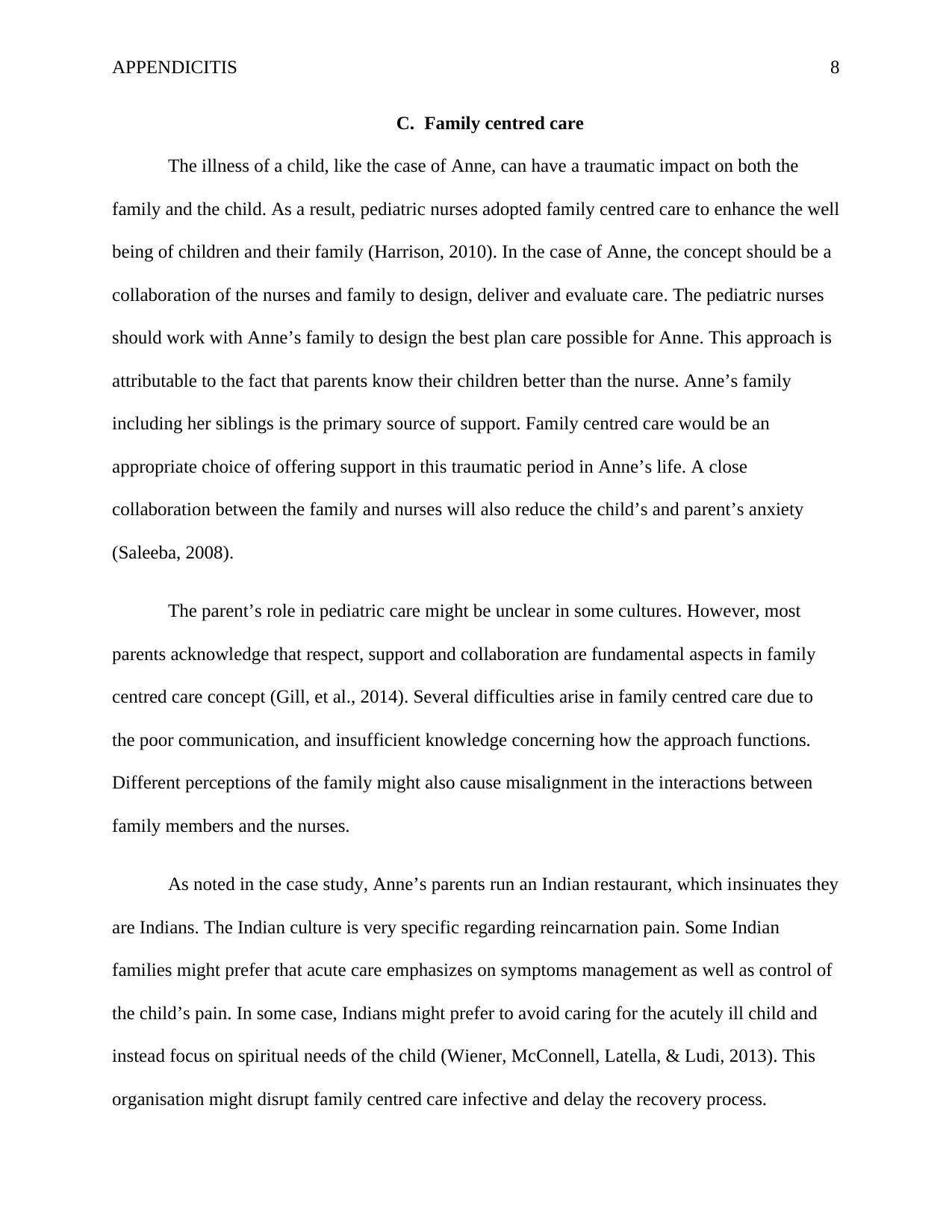
APPENDICITIS 8
C. Family centred care
The illness of a child, like the case of Anne, can have a traumatic impact on both the
family and the child. As a result, pediatric nurses adopted family centred care to enhance the well
being of children and their family (Harrison, 2010). In the case of Anne, the concept should be a
collaboration of the nurses and family to design, deliver and evaluate care. The pediatric nurses
should work with Anne’s family to design the best plan care possible for Anne. This approach is
attributable to the fact that parents know their children better than the nurse. Anne’s family
including her siblings is the primary source of support. Family centred care would be an
appropriate choice of offering support in this traumatic period in Anne’s life. A close
collaboration between the family and nurses will also reduce the child’s and parent’s anxiety
(Saleeba, 2008).
The parent’s role in pediatric care might be unclear in some cultures. However, most
parents acknowledge that respect, support and collaboration are fundamental aspects in family
centred care concept (Gill, et al., 2014). Several difficulties arise in family centred care due to
the poor communication, and insufficient knowledge concerning how the approach functions.
Different perceptions of the family might also cause misalignment in the interactions between
family members and the nurses.
As noted in the case study, Anne’s parents run an Indian restaurant, which insinuates they
are Indians. The Indian culture is very specific regarding reincarnation pain. Some Indian
families might prefer that acute care emphasizes on symptoms management as well as control of
the child’s pain. In some case, Indians might prefer to avoid caring for the acutely ill child and
instead focus on spiritual needs of the child (Wiener, McConnell, Latella, & Ludi, 2013). This
organisation might disrupt family centred care infective and delay the recovery process.
C. Family centred care
The illness of a child, like the case of Anne, can have a traumatic impact on both the
family and the child. As a result, pediatric nurses adopted family centred care to enhance the well
being of children and their family (Harrison, 2010). In the case of Anne, the concept should be a
collaboration of the nurses and family to design, deliver and evaluate care. The pediatric nurses
should work with Anne’s family to design the best plan care possible for Anne. This approach is
attributable to the fact that parents know their children better than the nurse. Anne’s family
including her siblings is the primary source of support. Family centred care would be an
appropriate choice of offering support in this traumatic period in Anne’s life. A close
collaboration between the family and nurses will also reduce the child’s and parent’s anxiety
(Saleeba, 2008).
The parent’s role in pediatric care might be unclear in some cultures. However, most
parents acknowledge that respect, support and collaboration are fundamental aspects in family
centred care concept (Gill, et al., 2014). Several difficulties arise in family centred care due to
the poor communication, and insufficient knowledge concerning how the approach functions.
Different perceptions of the family might also cause misalignment in the interactions between
family members and the nurses.
As noted in the case study, Anne’s parents run an Indian restaurant, which insinuates they
are Indians. The Indian culture is very specific regarding reincarnation pain. Some Indian
families might prefer that acute care emphasizes on symptoms management as well as control of
the child’s pain. In some case, Indians might prefer to avoid caring for the acutely ill child and
instead focus on spiritual needs of the child (Wiener, McConnell, Latella, & Ludi, 2013). This
organisation might disrupt family centred care infective and delay the recovery process.
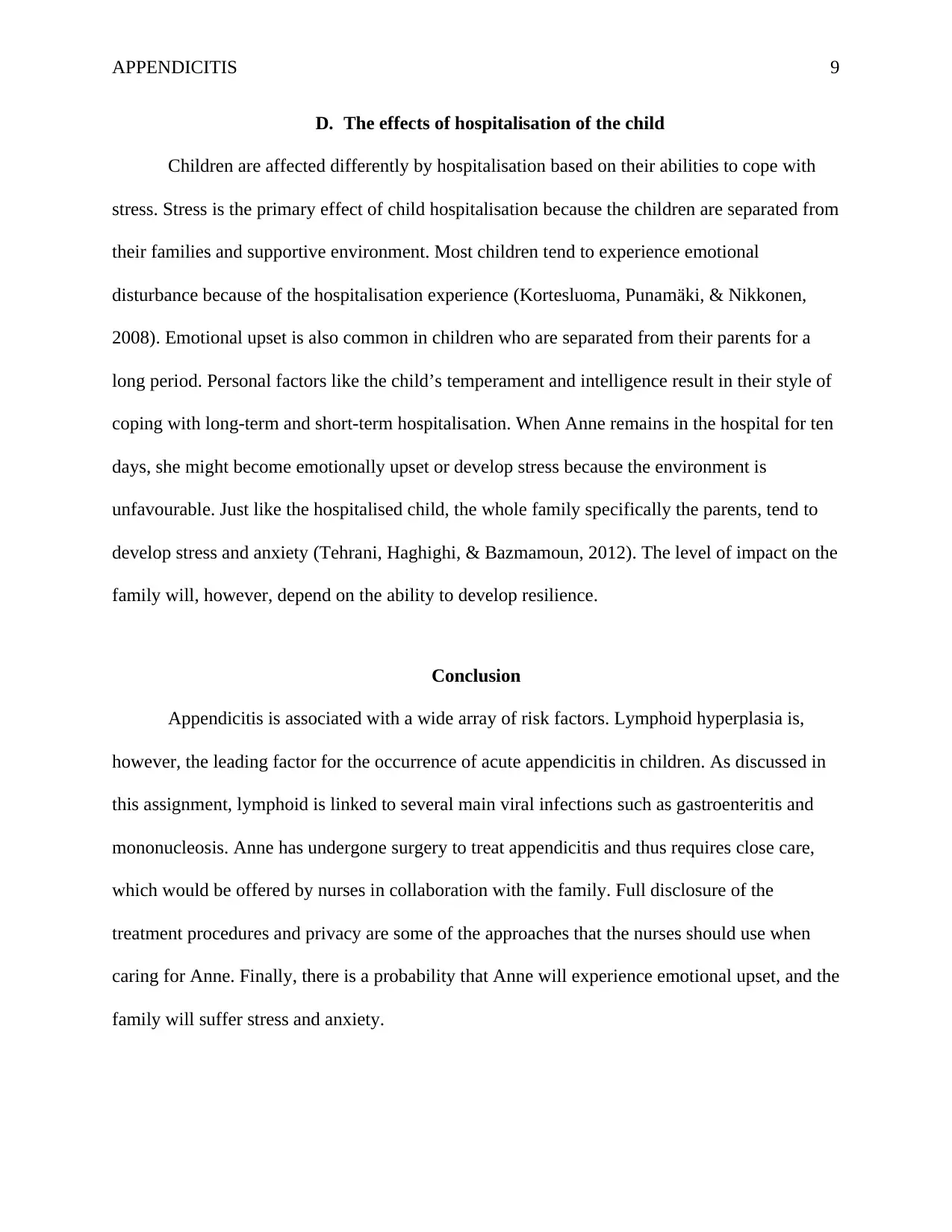
APPENDICITIS 9
D. The effects of hospitalisation of the child
Children are affected differently by hospitalisation based on their abilities to cope with
stress. Stress is the primary effect of child hospitalisation because the children are separated from
their families and supportive environment. Most children tend to experience emotional
disturbance because of the hospitalisation experience (Kortesluoma, Punamäki, & Nikkonen,
2008). Emotional upset is also common in children who are separated from their parents for a
long period. Personal factors like the child’s temperament and intelligence result in their style of
coping with long-term and short-term hospitalisation. When Anne remains in the hospital for ten
days, she might become emotionally upset or develop stress because the environment is
unfavourable. Just like the hospitalised child, the whole family specifically the parents, tend to
develop stress and anxiety (Tehrani, Haghighi, & Bazmamoun, 2012). The level of impact on the
family will, however, depend on the ability to develop resilience.
Conclusion
Appendicitis is associated with a wide array of risk factors. Lymphoid hyperplasia is,
however, the leading factor for the occurrence of acute appendicitis in children. As discussed in
this assignment, lymphoid is linked to several main viral infections such as gastroenteritis and
mononucleosis. Anne has undergone surgery to treat appendicitis and thus requires close care,
which would be offered by nurses in collaboration with the family. Full disclosure of the
treatment procedures and privacy are some of the approaches that the nurses should use when
caring for Anne. Finally, there is a probability that Anne will experience emotional upset, and the
family will suffer stress and anxiety.
D. The effects of hospitalisation of the child
Children are affected differently by hospitalisation based on their abilities to cope with
stress. Stress is the primary effect of child hospitalisation because the children are separated from
their families and supportive environment. Most children tend to experience emotional
disturbance because of the hospitalisation experience (Kortesluoma, Punamäki, & Nikkonen,
2008). Emotional upset is also common in children who are separated from their parents for a
long period. Personal factors like the child’s temperament and intelligence result in their style of
coping with long-term and short-term hospitalisation. When Anne remains in the hospital for ten
days, she might become emotionally upset or develop stress because the environment is
unfavourable. Just like the hospitalised child, the whole family specifically the parents, tend to
develop stress and anxiety (Tehrani, Haghighi, & Bazmamoun, 2012). The level of impact on the
family will, however, depend on the ability to develop resilience.
Conclusion
Appendicitis is associated with a wide array of risk factors. Lymphoid hyperplasia is,
however, the leading factor for the occurrence of acute appendicitis in children. As discussed in
this assignment, lymphoid is linked to several main viral infections such as gastroenteritis and
mononucleosis. Anne has undergone surgery to treat appendicitis and thus requires close care,
which would be offered by nurses in collaboration with the family. Full disclosure of the
treatment procedures and privacy are some of the approaches that the nurses should use when
caring for Anne. Finally, there is a probability that Anne will experience emotional upset, and the
family will suffer stress and anxiety.
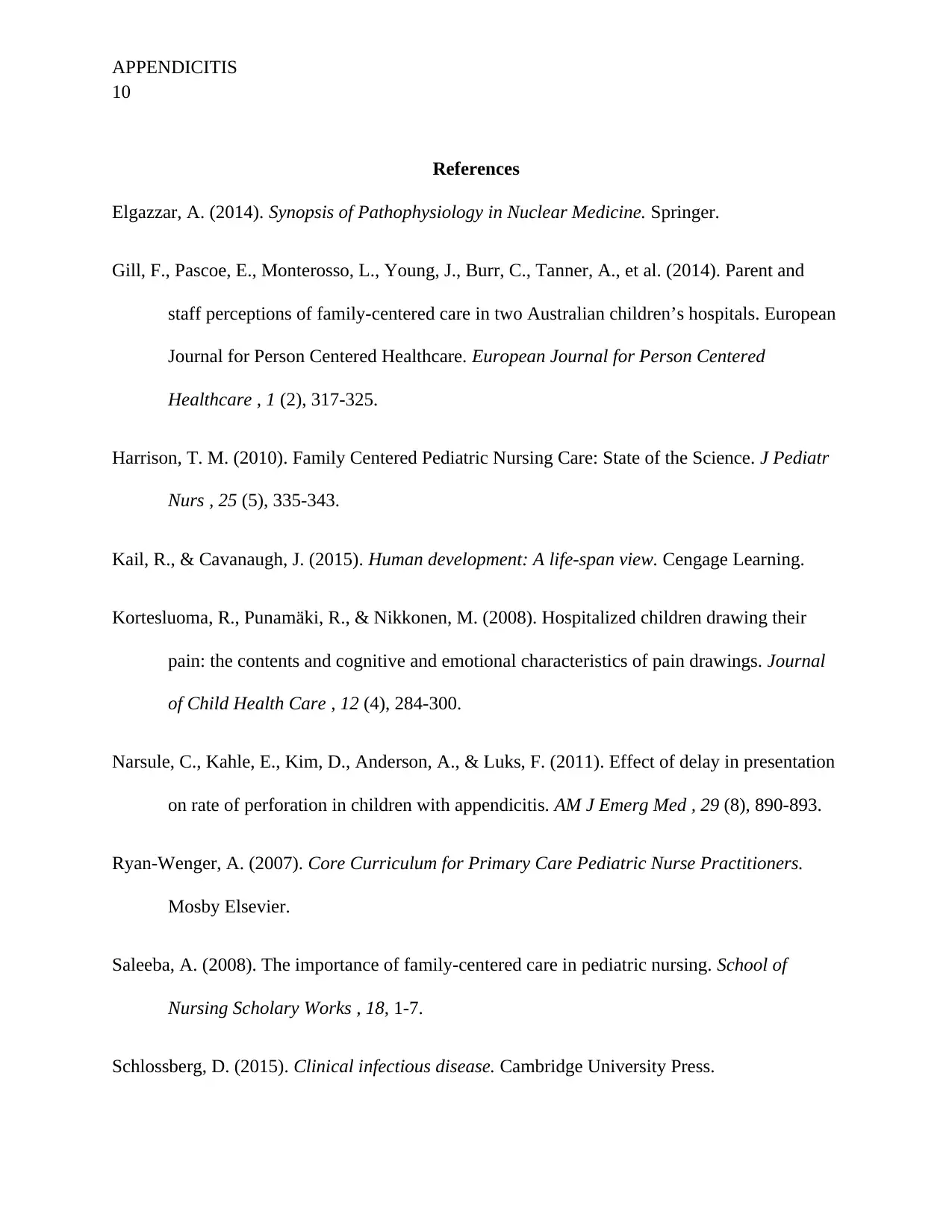
APPENDICITIS
10
References
Elgazzar, A. (2014). Synopsis of Pathophysiology in Nuclear Medicine. Springer.
Gill, F., Pascoe, E., Monterosso, L., Young, J., Burr, C., Tanner, A., et al. (2014). Parent and
staff perceptions of family-centered care in two Australian children’s hospitals. European
Journal for Person Centered Healthcare. European Journal for Person Centered
Healthcare , 1 (2), 317-325.
Harrison, T. M. (2010). Family Centered Pediatric Nursing Care: State of the Science. J Pediatr
Nurs , 25 (5), 335-343.
Kail, R., & Cavanaugh, J. (2015). Human development: A life-span view. Cengage Learning.
Kortesluoma, R., Punamäki, R., & Nikkonen, M. (2008). Hospitalized children drawing their
pain: the contents and cognitive and emotional characteristics of pain drawings. Journal
of Child Health Care , 12 (4), 284-300.
Narsule, C., Kahle, E., Kim, D., Anderson, A., & Luks, F. (2011). Effect of delay in presentation
on rate of perforation in children with appendicitis. AM J Emerg Med , 29 (8), 890-893.
Ryan-Wenger, A. (2007). Core Curriculum for Primary Care Pediatric Nurse Practitioners.
Mosby Elsevier.
Saleeba, A. (2008). The importance of family-centered care in pediatric nursing. School of
Nursing Scholary Works , 18, 1-7.
Schlossberg, D. (2015). Clinical infectious disease. Cambridge University Press.
10
References
Elgazzar, A. (2014). Synopsis of Pathophysiology in Nuclear Medicine. Springer.
Gill, F., Pascoe, E., Monterosso, L., Young, J., Burr, C., Tanner, A., et al. (2014). Parent and
staff perceptions of family-centered care in two Australian children’s hospitals. European
Journal for Person Centered Healthcare. European Journal for Person Centered
Healthcare , 1 (2), 317-325.
Harrison, T. M. (2010). Family Centered Pediatric Nursing Care: State of the Science. J Pediatr
Nurs , 25 (5), 335-343.
Kail, R., & Cavanaugh, J. (2015). Human development: A life-span view. Cengage Learning.
Kortesluoma, R., Punamäki, R., & Nikkonen, M. (2008). Hospitalized children drawing their
pain: the contents and cognitive and emotional characteristics of pain drawings. Journal
of Child Health Care , 12 (4), 284-300.
Narsule, C., Kahle, E., Kim, D., Anderson, A., & Luks, F. (2011). Effect of delay in presentation
on rate of perforation in children with appendicitis. AM J Emerg Med , 29 (8), 890-893.
Ryan-Wenger, A. (2007). Core Curriculum for Primary Care Pediatric Nurse Practitioners.
Mosby Elsevier.
Saleeba, A. (2008). The importance of family-centered care in pediatric nursing. School of
Nursing Scholary Works , 18, 1-7.
Schlossberg, D. (2015). Clinical infectious disease. Cambridge University Press.
Secure Best Marks with AI Grader
Need help grading? Try our AI Grader for instant feedback on your assignments.
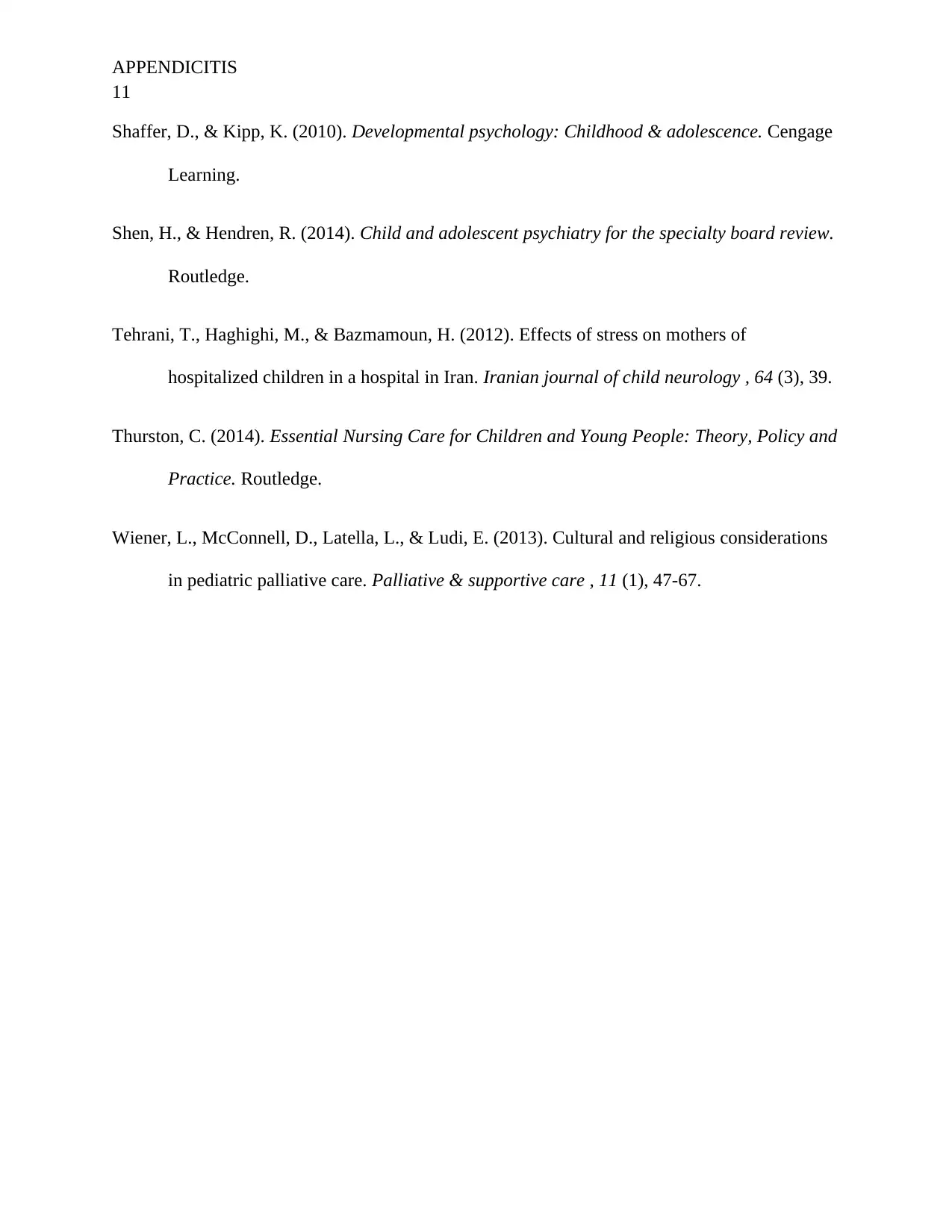
APPENDICITIS
11
Shaffer, D., & Kipp, K. (2010). Developmental psychology: Childhood & adolescence. Cengage
Learning.
Shen, H., & Hendren, R. (2014). Child and adolescent psychiatry for the specialty board review.
Routledge.
Tehrani, T., Haghighi, M., & Bazmamoun, H. (2012). Effects of stress on mothers of
hospitalized children in a hospital in Iran. Iranian journal of child neurology , 64 (3), 39.
Thurston, C. (2014). Essential Nursing Care for Children and Young People: Theory, Policy and
Practice. Routledge.
Wiener, L., McConnell, D., Latella, L., & Ludi, E. (2013). Cultural and religious considerations
in pediatric palliative care. Palliative & supportive care , 11 (1), 47-67.
11
Shaffer, D., & Kipp, K. (2010). Developmental psychology: Childhood & adolescence. Cengage
Learning.
Shen, H., & Hendren, R. (2014). Child and adolescent psychiatry for the specialty board review.
Routledge.
Tehrani, T., Haghighi, M., & Bazmamoun, H. (2012). Effects of stress on mothers of
hospitalized children in a hospital in Iran. Iranian journal of child neurology , 64 (3), 39.
Thurston, C. (2014). Essential Nursing Care for Children and Young People: Theory, Policy and
Practice. Routledge.
Wiener, L., McConnell, D., Latella, L., & Ludi, E. (2013). Cultural and religious considerations
in pediatric palliative care. Palliative & supportive care , 11 (1), 47-67.
1 out of 11
Your All-in-One AI-Powered Toolkit for Academic Success.
+13062052269
info@desklib.com
Available 24*7 on WhatsApp / Email
![[object Object]](/_next/static/media/star-bottom.7253800d.svg)
Unlock your academic potential
© 2024 | Zucol Services PVT LTD | All rights reserved.





